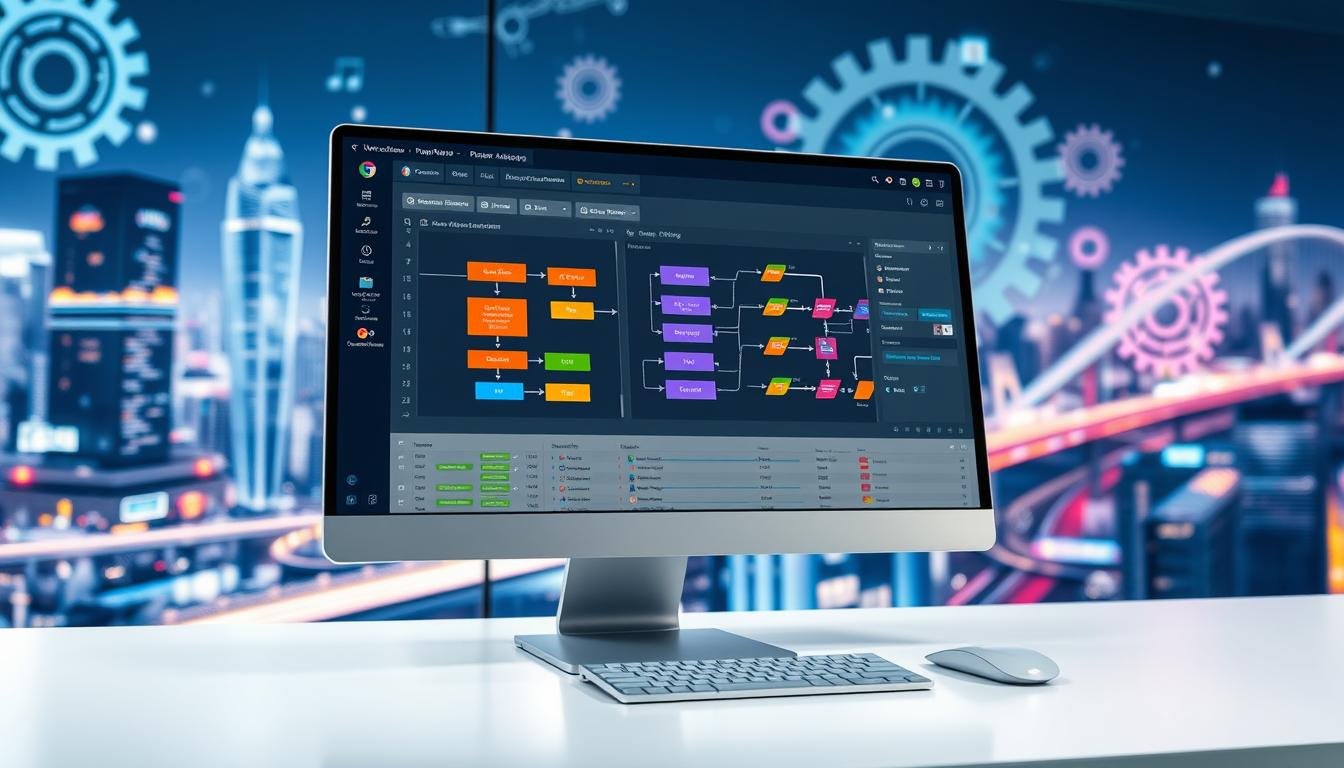Did you know that companies using automation see a 30% boost in efficiency in just one year? This shows how vital tools like Power Automate Desktop are. They help improve automated processes, and Power Automate Desktop's subflows are a key feature for handling complex workflows efficiently.

This article explores how subflows can improve your workflow. We cover everything from what subflows are to their benefits and how to use them. We aim to help you get the most out of Power Automate Desktop automation.
Key Takeaways
- Understanding what sub-flows are in Power Automate Desktop
- Importance of sub-flows in improving workflow automation
- The benefits of using sub-flows for enhanced efficiency and consistency
- How to create and implement sub-flows effectively
- Common challenges and solutions when dealing with sub-flows
Introduction to Power Automate Desktop Subflows
Learning to use subflows is key for anyone wanting to get good at Power Automate Desktop subflows. These parts help make workflows more modular and reusable. They break down big tasks into smaller, more manageable parts, improving your automation.
What Are Subflows in Power Automate Desktop?
Subflows in Power Automate Desktop are like smaller flows inside a bigger one. They handle specific tasks, making them easier to manage. The idea of subflow basics is to create these small blocks of automation. They can be used when needed, making your workflow more straightforward and efficient.
Importance of Subflows in Workflow Automation
Subflows are very important in an automation strategy. They help organize and do repetitive tasks, saving time and reducing errors. By using subflows, you build blocks that can be tested and used in different parts of your workflows. This makes your Power Automate Desktop subflows more consistent and reliable.
Benefits of Power Automate Desktop Subflows
Using Power Automate Desktop subflows brings many benefits to businesses. It helps improve workflow processes by making them better, more consistent, and adaptable.
Enhanced Workflow Efficiency
Power Automate Desktop subflows make workflows much more efficient. They break down big tasks into smaller, more manageable parts, allowing teams to work faster and more accurately.
This setup is key for making workflows better and smoother. It helps businesses run more efficiently.
Improved Automation Consistency
It is important to keep automation consistent. Power Automate Desktop subflows help ensure all workflows follow the same rules, leading to fewer mistakes and more reliable results.
Scalability and Flexibility
Power Automate Desktop subflows are also great because they grow with your business. They can change and grow as your needs change, allowing your workflows to handle more without losing quality or speed.
How to Create Subflows in Power Automate Desktop
Step-by-step Guide
- Open Power Automate Desktop: Launch the application to begin.
- Create a new flow: Navigate to the "New Flow" section and add a descriptive name.
- Add actions: Insert the necessary actions that form the subflow.
- Right-click in the flow view, select "Add Subflow," and give it a meaningful name.
- Transfer actions: Move the relevant actions into the subflow to modularize the process.
- Invoke subflow: Use the "Run Subflow" action in the main flow.
- Test your subflow: Ensure it runs as expected without errors.
Best Practices for Subflows
Follow these best practices to make your sub-flows better:
- Keep sub-flows modular: Ensure each subflow performs a distinct task to maximize reusability.
- Use descriptive naming: Name your subflows and actions clearly to make the workflow easy to understand and navigate.
- Regularly test subflows: Conduct thorough testing each time a new subflow is created or modified to catch issues early.
- Maintain documentation: Document the purpose and functionality of each subflow to aid in future updates and troubleshooting.
- Optimize performance: Continuously monitor and refine your subflows to ensure optimal performance, minimizing delays or errors.
By following these tips and using the step-by-step guide, you can make subflows that improve your workflow automation.
Utilizing Subflows in Power Automate Desktop
Subflows in Power Automate Desktop offer many ways to improve automation workflows. They help make processes smoother, leading to a better work environment. We'll examine real-world examples and learn how to link sub-flows with main flows.
Use Case Examples
One big use for subflows is in data processing. For instance, a company might have a main flow to get data from a system. Subflows can then handle data processing and formatting. This way, updates to subflows don't mess up the main flow.
Subflows are also great for conditional logic. Consider an email system that acts differently based on email content. Subflows can handle tasks like sending or organizing emails, keeping the main flow simple and clear.
Integration with Main Flows
Adding sub-flows to main flows improves automation. It's wise to spot repetitive tasks in your main flow and turn them into subflows. This makes your main flow simpler and your automation easier to grow.
Subflows also make your automation more flexible. By making subflows reusable, you can use them in many main flows. This creates a system that's both adaptable and effective at its tasks.
In summary, using subflows in Power Automate Desktop is a big win. With smart integration, businesses can create a top-notch, scalable, and flexible automation setup.
Exploring Power Automate Subflow Capabilities
Power Automate sub-flows are a game-changer for workflow automation. They allow users to access and customize advanced features to fit their business needs, making automation more powerful and efficient.
Advanced Features
Power Automate's advanced features meet complex automation needs. Subflows break down large workflows into smaller parts, making them easier to manage and update.
- Conditional Logic: Adding decision-making with if-then statements.
- Dynamic Content: Using variables and data from various sources for flexible workflows.
- Error Handling: Managing exceptions and errors to keep workflows running smoothly.
Customization Options
Power Automate customization lets users tailor subflows to their needs. This boosts workflow functionality and efficiency. Key customization options include:
| Customization Option | Description |
|---|---|
| Custom Actions | Creating custom actions for specific tasks not covered by built-in actions. |
| Workflow Templates | Using pre-built templates for standard processes and modifying them for unique needs. |
| API Integrations | Integrating with third-party apps and services to expand Power Automate's functionality. |
Businesses can improve their subflow capabilities by exploring and using advanced features and customization options. This leads to more efficient and effective workflows.
Common Challenges and Solutions
Working with Power Automate Desktop subflows can be rewarding but also challenging. It's key to tackle these problems head-on to keep things running smoothly. This section will cover common issues and offer solutions.
Troubleshooting Subflows
Running into problems with subflows is common. Here are some troubleshooting tips:
- Error Identification: Look at error logs to determine where and why a subflow failed.
- Isolation Testing: Test each part separately to find the problem.
- Resource Allocation: Make sure your system has enough resources for the tasks.
"Debugging is as much an art as it is a science. Patience and systematic testing are key."
Optimizing Performance
Keeping subflows efficient is vital. Here are some tips for better performance:
- Streamline Processes: Cut out unnecessary steps to speed up execution.
- Parallel Processing: Use parallel processing for multiple tasks when possible.
- Regular Updates: Keep your Power Automate Desktop software updated for better performance.
By following these tips, you can make your subflows run at their best. This will strengthen your overall workflow.
Maintaining and Updating Subflows
Keeping subflows up to date is crucial for smooth workflow automation. Here are some best practices:
- Documentation: Keep detailed documentation for each subflow, explaining every step and purpose.
- Frequent Testing: Regularly test subflows to ensure they work as expected after changes.
- Version Control: Use version control to track changes and return to previous versions if needed.
By being proactive with subflow maintenance, you can avoid problems and keep performance steady over time.
Conclusion
Power Automate Desktop subflows are key to better workflow automation. They help make complex tasks more manageable, enabling businesses to be more flexible and meet changing needs.
We showed how to create and use subflows. We gave a detailed guide and tips to make it work well. This is great for anyone wanting to improve their workflow.
Subflows in Power Automate Desktop improve workflows and efficiency. They help solve problems and keep things running smoothly. Try out Power Automate Desktop subflows to boost your work's efficiency and productivity.
FAQ
What Are Subflows in Power Automate Desktop?
Subflows in Power Automate Desktop are small parts of an automated workflow. They help break down significant processes into smaller, more manageable tasks, making them easier to manage and improve.
How Do Subflows Benefit Workflow Automation?
Subflows save time and reduce errors in automation. They make complex tasks simpler. This helps you manage and grow your workflows more efficiently.
What Are the Key Advantages of Implementing Subflows?
Subflows improve workflow efficiency and consistency, as well as the scalability and flexibility of automation. This leads to more reliable and streamlined business processes.
How Can I Create Subflows in Power Automate Desktop?
To create subflows, start by defining the tasks you want to automate. Then, set up the subflow in Power Automate Desktop. Integrate it well with your main flow and follow best practices to make it effective.
Can You Provide Examples of Using Subflows in Power Automate Desktop?
Sure! Subflows automate tasks like data entry, email sending, and work approval. You can add these subflows to the main flows for more complex tasks.
What Advanced Features and Customization Options Do Subflows Offer?
Power Automate Desktop subflows have cool features like conditional logic and loops. They can also be customized to your business needs, making them useful for complex workflows.
What are the common challenges when working with sub-flows, and how can they be solved?
You might encounter issues such as fixing subflow errors or improving performance. To solve these, follow the best troubleshooting practices and monitor their effectiveness. Regular updates also help keep everything running smoothly.

